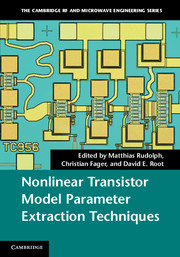Book contents
- Frontmatter
- Contents
- List of contributors
- Preface
- 1 Introduction
- 2 DC and thermal modeling: III–V FETs and HBTs
- 3 Extrinsic parameter and parasitic elements in III–V HBT and HEMT modeling
- 4 Uncertainties in small-signal equivalent circuit modeling
- 5 The large-signal model: theoretical foundations, practical considerations, and recent trends
- 6 Large and packaged transistors
- 7 Nonlinear characterization and modeling of dispersive effects in high-frequency power transistors
- 8 Optimizing microwave measurements for model construction and validation
- 9 Practical statistical simulation for efficient circuit design
- 10 Noise modeling
- Index
- References
6 - Large and packaged transistors
Published online by Cambridge University Press: 25 October 2011
- Frontmatter
- Contents
- List of contributors
- Preface
- 1 Introduction
- 2 DC and thermal modeling: III–V FETs and HBTs
- 3 Extrinsic parameter and parasitic elements in III–V HBT and HEMT modeling
- 4 Uncertainties in small-signal equivalent circuit modeling
- 5 The large-signal model: theoretical foundations, practical considerations, and recent trends
- 6 Large and packaged transistors
- 7 Nonlinear characterization and modeling of dispersive effects in high-frequency power transistors
- 8 Optimizing microwave measurements for model construction and validation
- 9 Practical statistical simulation for efficient circuit design
- 10 Noise modeling
- Index
- References
Summary
Introduction
Microwave power transistors commonly internally consist of a number of smaller transistor cells combined together in order to reach the desired performance. The individual transistor cells are positioned side by side, sometimes repeated in two dimensions. But often, only one single line of parallel cells is used, since power splitting and combining is less challenging compared to other configurations. Relying on an array of small transistors instead of only one large power transistor allows higher power at high frequencies to be realized. Reaching high frequencies calls for small and fast transistors. Inherently, reducing the physical size of a transistor will reduce the power-handling capabilities. Increasing the size of a single transistor with just one emitter or drain connection, on the other hand, is no option in the microwave regime, since unequal current or heat distribution within the device will rapidly degrade performance. Proper combination of many small transistors within a package to get one power device is therefore the only option. In addition to the advantages regarding electrical behavior, thermal management of the power transistor can be significantly simplified.
Various configurations of transistors in packages have emerged in recent years. Common to most of these solutions is the arrangement in bars, as single or multiline (i.e., 2D). However, 2D configurations of bars restrict the power transistor to lower frequencies where line lengths in general (e.g., bondwires) are small compared to the wavelength.
- Type
- Chapter
- Information
- Nonlinear Transistor Model Parameter Extraction Techniques , pp. 171 - 205Publisher: Cambridge University PressPrint publication year: 2011
References
- 1
- Cited by



